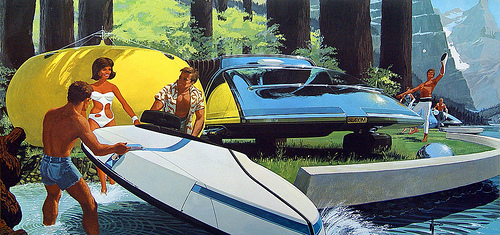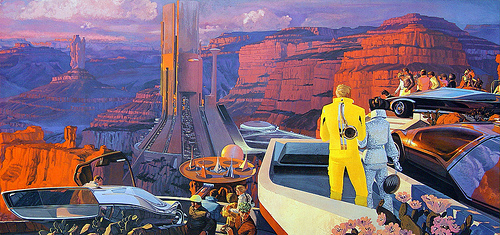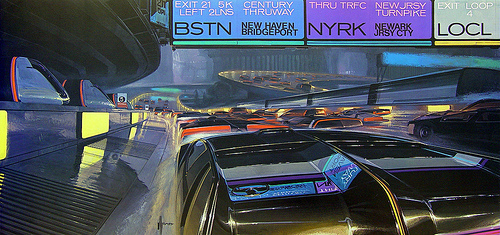





For years, conceptual designer Syd Mead has been the man to whom companies go when they need to advance an audacious vision of the impending future.
Sydney Jay Mead was born in 1933, in Saint Paul, MN, to a Baptist minister and his wife. After graduating from the Art Center in Los Angeles in 1959, he worked at Ford Motor Company’s Advanced Styling Center in Dearborn, MI for two years. He then spent part of the next decade rendering now legendary concept illustration for U.S. Steel, above. “He painted,” one Mead fan site notes, “using a slick, detailed method that made the future seem fresh, clean, and thrilling.” He started Syd Mead, Inc. in 1970.

 Soon, Hollywood came calling with movies that required his ultra-hard, visually authentic and tactile designs. (Mead lists his favorite metal as “chrome,” and his favorite color is, gulp, “Cherenkov radiation blue.”) His indelible technological notions were then emblazoned on sci-fi like Star Trek: The Motion Picture, Aliens, and Tron. (Indeed, some would argue that his US Steel snow walker, above right, obviously influenced another one in a galaxy far, far away, below right.)
Soon, Hollywood came calling with movies that required his ultra-hard, visually authentic and tactile designs. (Mead lists his favorite metal as “chrome,” and his favorite color is, gulp, “Cherenkov radiation blue.”) His indelible technological notions were then emblazoned on sci-fi like Star Trek: The Motion Picture, Aliens, and Tron. (Indeed, some would argue that his US Steel snow walker, above right, obviously influenced another one in a galaxy far, far away, below right.)


 But it was Blade Runner, right, Ridley Scott’s 1982 classic, on which Mead’s dystopic gigalopolis, both below right, most sears every frame. “In essence,” says author Paul Sammon (Future Noir: The Making of Blade Runner), “what you’re seeing in many shots are almost three-dimensional representations of Syd Mead’s art.”
But it was Blade Runner, right, Ridley Scott’s 1982 classic, on which Mead’s dystopic gigalopolis, both below right, most sears every frame. “In essence,” says author Paul Sammon (Future Noir: The Making of Blade Runner), “what you’re seeing in many shots are almost three-dimensional representations of Syd Mead’s art.”
Sammon, Mead, director Steven Lisberger (Tron) and other industry vets testify in director Joaquin Montalvan’s 2005 documentary, Visual Futurist: The Art & Life of Syd Mead. The film tells Mead’s story from his own perspective, as well as from that of the people with whom he’s worked. It’s a rich document about a little-known man, but one whose whose ideas are deeply and widely embedded in American popular culture.
Joaquin Montalvan is a guest today on my WBAI-NY / 99.5 FM radio show, NONFICTION, this afternoon, Friday, August 21, at 2 pm ET.
But first we’ll speak to Jason Del Gandio, author of Rhetoric for Radicals: A Handbook for 21st Century Activist, a guide for the ultra-political on how to effectively communicate. “Here’s the underlying logic” of his book, Del Gandio says:
• Change the rhetoric and you change the communication.
• Change the communication and you change the experience.
• Change the experience and you change a person’s orientation to the world.
• Change that orientation and you create conditions for profound social change.
You can hear Jason Del Gandio’s and Joaquin Montalvan’s ideas by tuning in at 2 pm. If you’re outside of the New York tri-state, check out our stream on the web. If you miss the live show, dig into our archives for up to 90 days after broadcast.

0 comments ↓
There are no comments yet...Kick things off by filling out the form below.
Leave a Comment